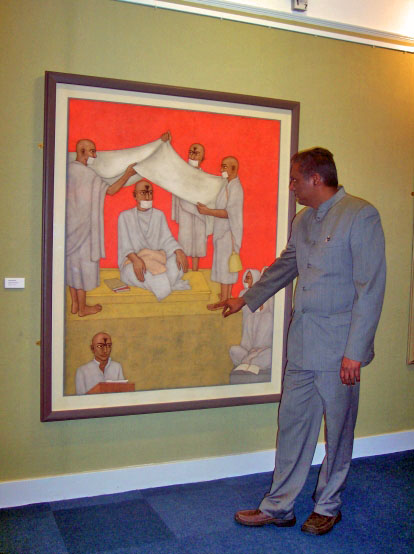
A good painting inspires. A good painting encourages. A good painting makes us think and reflect. Shanti Panchal’s ‘Padabhishek’ depicting the promotion of a Jain monk to the highest rank - that of Acharya, achieves all this and something else too. Through its beautiful penetrating eyes, it provokes and questions us - who are we, and where do we stand? What is it that makes us who we are? And Shanti encourages us to reflect through this painting - in a beautiful non-threatening way.
The painting was exhibited at the Chelmsford Museum in Essex in England in January and February 2007, curated by Anne Lutyens-Humphrey. I was invited to give a public lecture on this masterpiece and felt it an honour and a challenge as a Jain living in contemporary society. What follows is my analysis of the picture and its significance for the modern world.
This 5X7 foot masterpiece was commissioned by a Jain diamond merchant in Mumbai (Mr. Russell Mehta) who invited the artist to witness the live ceremony and then paint his impression of it. Over 10,000 people attended this event, and no photographs were allowed, so Shanti drew lots of sketches. The final result is not an illustration, but an artist’s impression of the ceremony. The first curiosity the painting arouses is the question - who are these white robed masked monks and what are they doing? This leads the viewer into investigating Jainism, one of the oldest religious traditions of this world and also one of the least known and understood. Writing as a Jain, this work opens a contemporary window to this tradition which makes me proud - as it is such a vast ocean of culture, and so necessary for world attention and study. Yet it is so mis-understood, even by young Jains raised in this tradition.
Jainism originated in India thousands of years ago, with clear scientific evidence of the existence of Mahavira, the 24th Tirthankara who was born in 599 BC. Its primary focus is on the respect and reverence for all life - Ahimsa. The pillars of the tradition are Jain monks and nuns, who live a life of simplicity, celebacy and total dedication to self-realisation. They are the role models, the living interpreters and teachers of the tradition, and this painting focuses on them. Art has been central to the tradition for thousands of years, and some of the most beautiful and intricate temples in India today are Jain - the most famous being the Delwara and Ranakpur temples in Rajasthan and the Palitana temples in Gujarat. Built with white marble, they are serene spaces, filled with the glow of natural light and the coolness of marble, with murtis or images of tirthankaras as the central focus. Visitors to these temples leave with a lasting imprint on their memories. They were commissioned by wealthy Jain merchants and statesmen who saw in artistic commission and temple building, a sublime act of philanthropy. Russell Mehta has also continued this tradition by commissioning this painting and in this way, used his profits for a just cause. Shanti Panchal has through his artistry, helped Jains to continue their artistic heritage by making it living and real. Despite the huge amount of temple building that goes on among Jains in India today, there is very little in terms of quality creativity and imagination. At best, we try to replicate the old. Here, Shanti has taken from the old and created something new, fresh and timeless at the same time.
The qualities of the painting are simplicity, humility, serenity, harmony and creativity. These are also the fundamental values of the Jain tradition, and the artist captures them in breathtaking accuracy. The colours are all very natural and blend together very well to create a vivid composition. The painting depicts the ceremony of the promotion of a Jain monk to Acharya - the highest rank possible. There is really no pomp and ceremony, the gift being given is that of a white shawl - which is a symbolic gesture of honour. The painting shows fellow monks robing the Acharya with this new shawl. That is the most these saints can accept as they are not supposed to have any possessions.
The modern world is seething with disharmony and environmental destruction. Here is a timeless tradition which has not only showed the way to simple and harmonious living, but has lived it and also survived intact for thousands of years. This ceremony could be switched back in time for two thousand years, and it would still be the same. The tradition has survived in spite of history and continues to flourish to this day. There is a timelessness about this painting which is extraordinary. It manages to capture the integrity of the tradition and its in-built sustainable qualities. The modern world knows little about the Jains, and pretends as if it is inventing new concepts like vegetarianism, sustainability, light footprint, …. when these were lived for thousands of years before they were even labelled as such. This painting opens a new window to this beautiful ancient tradition, which the West needs to study if it wants to really learn about sustainable living. Honestly and not with the intention of making a quick profit.
The title of my lecture was ‘Compassion and Creativity’. Compassion is at the core of the Jain tradition, which embraces the spirit of Ahimsa (Reverence for All Life). True compassion requires imagination - otherwise how can one feel the pain of another? Creativity involves risk - a dive into the inner depths, without knowing where the artist will end up. These monks and nuns have risked their entire lives, for the sake of self-realisation. Panchal himself has undergone great risks and suffering to establish himself as an artist of the modern world. But he was patient and persevered, and this comes through in the painting - he recognised similar qualities in his subjects and thereby was able to capture this intimacy. Genuine creativity cannot come out of insecurity but from inner security - we live in a world of insecurity and materialism and that is why we are so starved of creativity. Zero and Infinity are numbers attributed to the Jain/Indian tradition. This painting captures both zero and infinity - we have to go down to zero in terms of our possessions and clutter, to unleash our infinite potential. When we go down to zero, we are at our charitable best and leave the least footprint - because we leave nature alone with its wealth and do not interfere to profit from it or destroy it. Also zero equals selflessness and infinite compassion. And creativity then oozes naturally, as it did with many of our ancient Acharyas who upheld and sustained the tradition. ‘Padabhishek’ salutes all the Acharyas of the Universe who have shown us the path of compassionate living.
It is a fact that most artists are recognised after they have died. It would be a real shame if Shanti’s unique art is left to this fate. It celebrates the diversity of Britain by giving attention to one of the least known communities, which has some of the most pristine ideals. He creatively awakens the best in us to serve the least of us.
 Dr. Atul Keshavji Shah
Dr. Atul Keshavji Shah